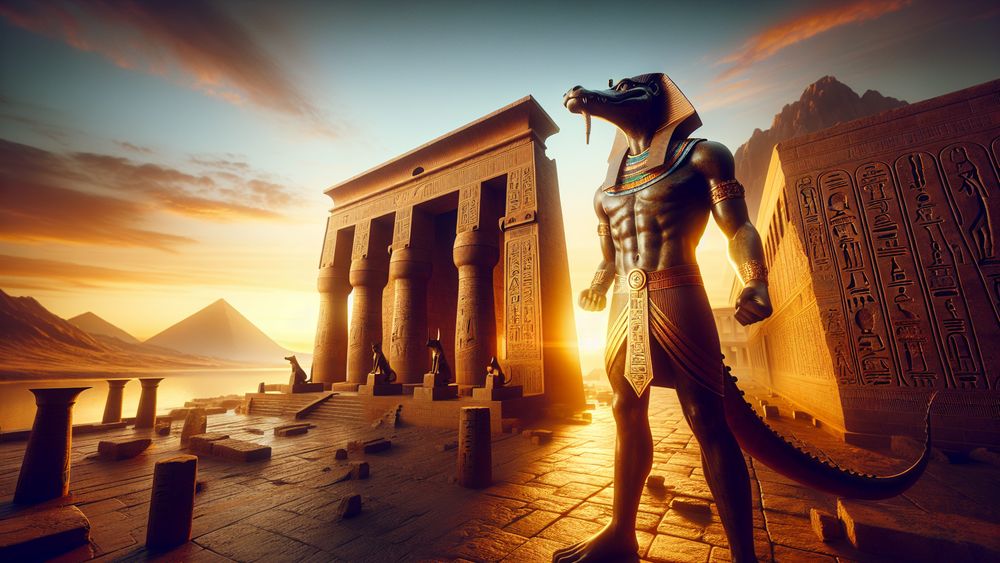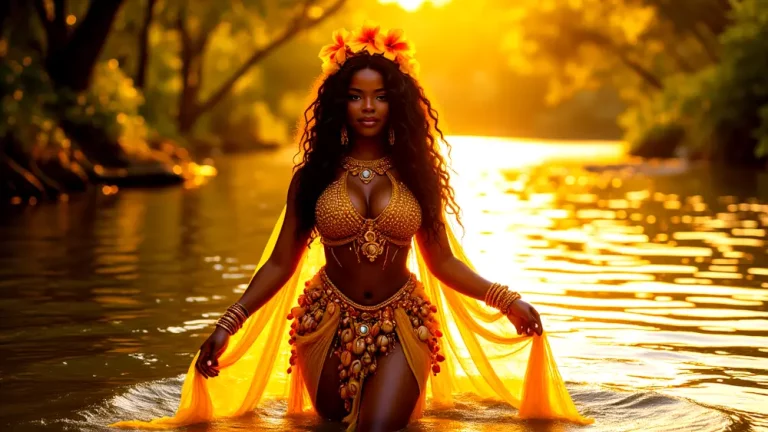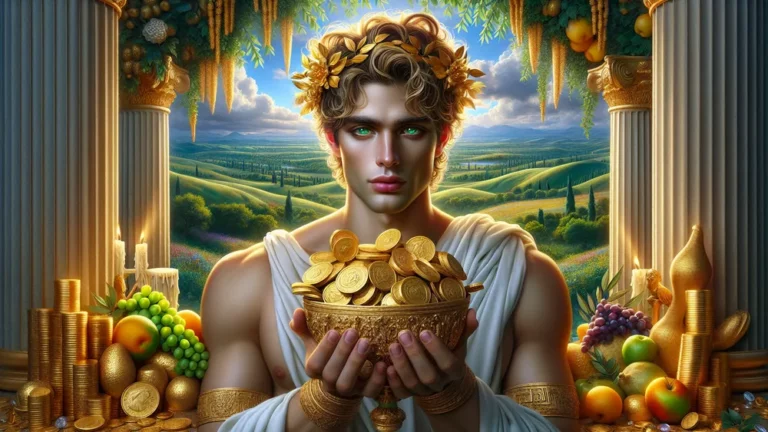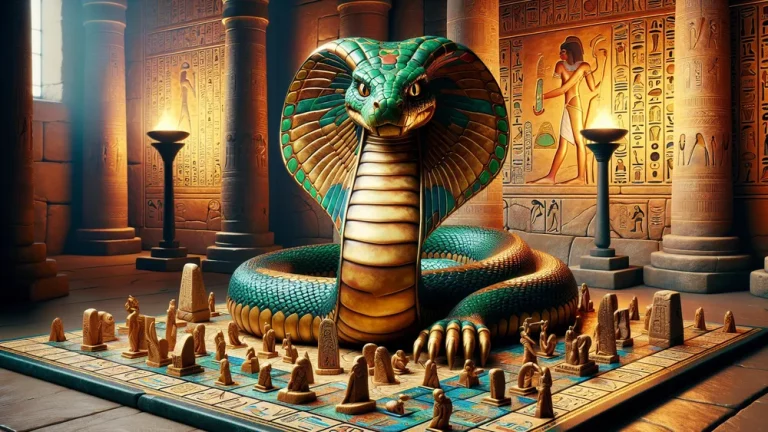Sobek And Anubis Relationship In Ancient Egypt
In the wide and varied world of ancient Egyptian mythology, where each god and goddess has a job that mirrors what people back then held close, Sobek and Anubis indeed make for an interesting pair. Sobek, that crocodile god, wraps himself in the power and life that the Nile River brings.
Key Points:
- The relationship between Sobek and Anubis complements each other, representing the cycle of life and afterlife.
- Anubis and Sobek are not considered brothers in ancient Egyptian mythology.
- Sobek and Anubis are key figures in ancient Egyptian mythology.
- Sobek symbolizes the Nile’s life-giving forces and fertility, while Anubis oversees mummification and guides souls after death.
- Sobek and Anubis play vital yet different roles in Egyptian beliefs and everyday life.
- Sobek is worshipped for fertility and protection, especially in places like Crocodilopolis and Kom Ombo temples.
- Anubis ensures the proper preparation of the dead for the afterlife and weighs hearts for truth.
- Sobek represents life and nature, while Anubis focuses on death and the afterlife.
On the other hand, Anubis, with his jackal head, takes charge of guiding souls after death and making sure mummification goes right. They both have their own corners in the spiritual and everyday lives of those ancient folks.
This piece digs into how Sobek and Anubis connect, looking at what they do, why they matter so much, and what their stories mean for the people who lived way back when. By doing so, we get to see the bigger role they play in Egyptian beliefs and tales.
Exploring the Deities: Sobek and Anubis
So, we’re heading into a space where we get to shine a light on two very interesting characters from ancient Egyptian stories. First off, we’re talking about Sobek and Anubis. These two have quite the job descriptions and roles that they play. Let’s really get into who they are and what they do.
Who Are Sobek and Anubis?
Sobek steps into the spotlight as the crocodile god in ancient Egyptian tales, where he shines as a symbol of the mighty and life-giving forces of the Nile River. This deity, which artists often show as a man with a crocodile head, directly links to fertility and safety, especially when talking about the Nile’s flood which is so key for growing crops.

On a different page, Anubis makes his mark with a jackal-headed look and takes charge of mummification and guiding souls after death. His job was super critical for preparing bodies for their final rest and for making sure souls got where they needed to go after leaving the earth.
Both these gods play huge parts in what ancient Egyptians thought and felt about life, death, and nature.
- They worshipped Sobek at places like the Faiyum and Kom Ombo temples, where people came together for rituals that asked for fertility and protection.
- Anubis gets the credit for coming up with how to embalm and for setting up sacred rites for those who passed away.
- The Nile’s flood, which Sobek had a strong connection to, mattered a lot for farming and making sure there was enough food.
- Anubis had a hand in the ceremony that involved weighing the heart, which showed how much ancient Egyptians cared about truth and being good in the afterlife.
Sobek and Anubis were essential deities in ancient Egyptian beliefs and practices, influencing ideas about life, death, and nature while overseeing crucial aspects like fertility, protection, mummification, and the afterlife.
The Nature of Their Relationship
So, when we look into how Sobek and Anubis fit together, it’s kind of like piecing together a puzzle where the pieces don’t always clearly show how they connect. Ancient Egyptian stories and beliefs indeed create a wide and complex network where gods and their stories intertwine.
While we don’t really stumble upon stories that directly throw Sobek and Anubis into the same scene, their roles hint at a relationship where they complement each other. Sobek, with his control over the Nile’s life-bringing powers, and Anubis, who looks after the dead and oversees mummification, each play vital yet very different parts.
These roles shine a light on what the Egyptians think about life’s cycle and the balance between living and afterlife matters. While Sobek ensures that people have what they need to live and thrive, thanks to the Nile, Anubis steps in to guide and protect those same folks after they pass away.
This setup gives us a full-circle view of existence, covering everything from coming into the world, living in it, and moving on to what comes next.
Are Sobek and Anubis Brothers?
Anubis and Sobek are not considered brothers in ancient Egyptian mythology. Their roles and family connections are distinct:
- Anubis is primarily known as the god of mummification and the afterlife. He is often depicted with the head of a jackal. According to various myths, Anubis is the son of Osiris and Nephthys, although in some stories his father is said to be Set.
- Sobek, on the other hand, is the god associated with the Nile crocodile and is connected with fertility, protection, and the might of the pharaohs. He is usually depicted as a man with a crocodile head. Sobek’s parentage varies in different myths but is often portrayed as the son of Neith, a primordial deity associated with war and weaving.
These gods have different domains and familial connections within the complex web of Egyptian mythology, where relationships can vary depending on the region and the period.
The Roles and Realms of Sobek and Anubis
So, after we’ve dug into who Sobek and Anubis are and how they fit together, we’re heading straight into a detailed look. This part focuses on what these two major figures from the ancient Egyptian roster of gods specifically do and where they hang out. It’s all about getting into the nitty-gritty of their day jobs and home bases in the world of myths.
Sobek’s Domain: Strength, Fertility, and the Nile
So, Sobek and his crocodiles, right? They’re a huge part of what makes the Nile so special for ancient Egyptians. Imagine this: the Nile River is basically the heart pumping life into Egypt. It’s where you get your water, food, and where you can travel up and down the country.

Sobek, that crocodile god, he’s like the mascot for all that good river gives – the crops, the fish, and even the transportation. People really respect him for that. They throw festivals, give food and shiny objects to please him and keep the good times rolling.
It’s all about keeping that balance with nature, where you’ve got to respect the river and its creatures but also protect yourself from them. Now, crocodiles themselves, they’re no joke. Big, strong, and scary. But for Egyptians, that’s Sobek in the flesh. They see these creatures and think of Sobek’s might and his protective vibe. Different places in Egypt have their own way of saying thanks to Sobek.
Take Crocodilopolis, which is now called Faiyum. People there literally deck crocodiles out in jewels and serve them gourmet meals. It’s their way of connecting with Sobek, asking for his protection while also acknowledging his power to give life and take it away. So when you see a crocodile, for Egyptians, it’s like seeing a piece of Sobek himself.
- Crocodilopolis (Faiyum): Where people literally make crocodiles sparkle and feast.
- Offerings and rituals: Think food, flowers, and sweet-smelling smoke to make Sobek happy.
- Symbolism in art: Sobek often gets shown as a dude with a crocodile head or simply as a crocodile.
- Protective amulets: Little crocodile figures people carry for that Sobek strength shield.
Anubis’s Realm: Mummification and the Afterlife
So, let’s talk about Anubis and his job which is super interesting. He’s the one with the head of a jackal, which might sound odd but totally makes sense when you get into it. He’s all about helping people after they die, which is a pretty big job if you think about it. He doesn’t do this alone though; he’s got rituals and ceremonies that he oversees.
These aren’t your average get-togethers. They’re full of steps to make sure the dead are ready for what comes next. Anubis makes sure that everyone gets where they need to go in the afterlife and that they’re all set for their next adventure. He’s like the ultimate guide and protector for when you’ve shuffled off this mortal coil. Now, for the jackal connection, which is quite direct and to the point.
Jackals hang around cemeteries, which is why Anubis is linked to them. It’s his way of saying he’s in charge of looking after the dead and making sure they’re safe. This whole setup that the ancient Egyptians had speaks volumes about how they see death and the afterlife.
They really wanted to make sure that when someone passed away, they had someone like Anubis on their side to help them out. It’s quite thoughtful when you break it down. Table: Responsibilities and Symbolism of Anubis
| Responsibility | Description |
|---|---|
| Guidence of Souls | Anubis takes the souls by the hand and leads them where they need to go after they die. |
| Embalming and Mummification | He’s in charge of making sure the dead are properly prepared for their afterlife trip, which includes a lot of cleaning and wrapping. |
| Weigher of Hearts | Anubis has this scale where he puts your heart on one side and a feather on the other to see if you’ve been good enough for the afterlife. |
| Symbolism | Description |
|---|---|
| Jackal-Head | This is because jackals are often seen around graves, which ties back to Anubis’s role as a guardian for those who have passed away. |
| Protector | He’s like a personal bodyguard for your soul, making sure you’re safe and sound on your way to what comes next. |
Anubis, with the head of a jackal, guides souls after death and ensures they are prepared for the afterlife, symbolizing protection and guardianship for the deceased.
The Cultural and Religious Significance
So, after we’ve dug into what Sobek and Anubis do and where they hang out, it’s time to shift gears. We’re heading into how these two made a splash in the lives of those ancient Egyptian folks and the kind of respect and attention they got.
Sobek and Anubis in Ancient Egyptian Society
In the society of ancient Egypt, people really looked up to Sobek and Anubis. They showed their respect and admiration through building places for worship and centers for their cults. Sobek, the one who looks like a crocodile, got a lot of love especially in Crocodilopolis. Here, they even kept live crocodiles in the temple of Sobek. People saw these crocodiles as real-life versions of the god.
This showed how much they connected Sobek with the Nile, which was super crucial for their survival and for everything to thrive. Then, there’s Anubis, with his jackal head. He was all about mummification and guiding the dead which was super serious for Egyptians because they saw the afterlife as a continuation of this life.
His main spot was Cynopolis where lots of rituals took place to honor him and to ask for his protection for those who passed away. So, for both these gods, Egyptians had their ways of saying thanks and asking for blessings.

For Sobek, it was about asking for his shield and for good crops, which totally makes sense because the Nile’s flooding was key for growing food. And for Anubis, it was about making sure that when someone dies, they’re safe and can move smoothly into the afterlife. Thus, honoring Sobek and Anubis wasn’t something on the side for Egyptians; it was part and parcel of their everyday and spiritual lives.
They really integrated these practices into their daily routines and their beliefs about life after death, which clearly tells us how central these gods were in the hearts and minds of ancient Egyptians.
The Legacy of Sobek and Anubis Today
Today, we see Sobek and Anubis everywhere in modern culture and media. They jump out from the pages of books and flash across screens in movies and video games. Sobek, with his powerful crocodile form, and Anubis, easily spotted by his jackal head, have indeed moved far from their mythological roots. Yet, they still grab our attention.
They show up in stories that may have little to do with their original myths but still hint at their ancient roles of protectors and guides. This shift has made these ancient Egyptian gods familiar faces, even to those who might know nothing about where they truly come from.
Their stories change to fit new plots and visuals but keep the essence that made them so respected thousands of years ago. Thus, Sobek and Anubis keep the magic of Egyptian mythology alive and kicking. They make sure it stays part of our world today, proving that these old gods still have the power to fascinate and inspire across the ages and cultures.

Pantheon of All the Egyptian Mythology Gods
So, when we talk about Egyptian mythology, it’s like opening a huge book filled with stories and characters. Each god and goddess has their own chapter, so to speak. You’ve probably heard of Ra and Isis. They’re like the celebrities of this world. Ra takes charge of the sun, while Isis is all about magic and being a mom. But that’s barely scratching the surface.
There are so many others, each with their own job and tale to tell. They’re like a massive family that looks after everything from your daily bread to where you’ll end up in the afterlife. For those who really want to get into the details and learn about every single one of these divine beings, there’s a place you can go.
Click right here for a full list of all the Egyptian gods. It’s a treasure trove for anyone curious enough to take a look.
FAQs
1. How were Sobek and Anubis worshipped differently in ancient Egypt?
In ancient Egypt, people worshipped Sobek and Anubis in ways that were quite distinct from each other. For Sobek, his connection with the Nile and its life-giving properties, along with fertility, stood at the center of his worship. On the other hand, Anubis took on a role that involved mummification and guiding the souls of the deceased into the afterlife.
Thus, while one god received veneration for bringing life and protection, the other was crucial for afterlife transitions and rituals.
2. Are there any myths where Sobek and Anubis work together?
So, when we look into the tales and stories that have come down to us from ancient Egypt, we don’t really find any where Sobek and Anubis team up and tackle challenges side by side. This fact shines a light on how their roles in the mythology don’t overlap but rather stick to their own lanes, which is quite interesting indeed.
3. How do Sobek and Anubis compare to other godly pairs in Egyptian mythology?
When we look at Sobek and Anubis and then turn our gaze to other divine duos in the ancient Egyptian spiritual landscape, we notice something quite distinct. These two, indeed, serve as a bridge. They connect the world where we live and breathe and the silent, mysterious domain of those who have passed on. This role they play, it’s unique.
4. What are the most famous temples dedicated to Sobek and Anubis?
So, when we talk about where people in ancient times showed their respect for Sobek and Anubis, two places jump out. First, for Sobek, there’s this spot called the Temple of Kom Ombo. It’s pretty special. Then, for Anubis, folks would head over to the Cenotaph at Saqqara. They really stood out back then.







